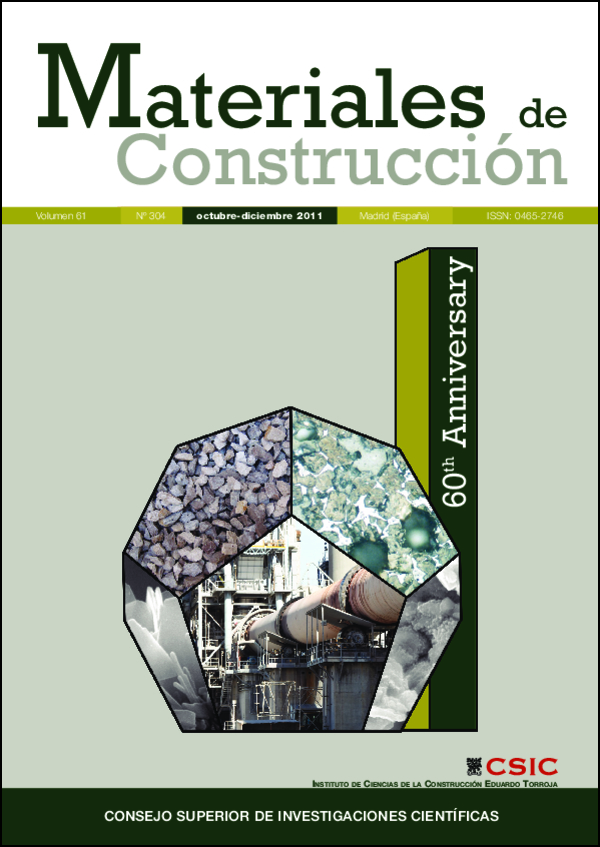The influence of water repellent products on the chromatic modifications of the ceramic brick
DOI:
https://doi.org/10.3989/mc.2011.57810Keywords:
Ceramic brick, Polymeric materials, Surface properties, Colour, Water repellentsAbstract
Chromatic variation, colour and luminosity, undergone by the ceramic support protected by the incorporation of a treatment with water repellent products, is analysed. A new methodology is suggested, based on RGB model where quantifiable values from each ceramic sample are obtained through digital measurement of the colour (image histograms), taking as a base the same type of ceramics with no water repellents. Chromatic variation is determined by the type of water repellent and the base material, obtaining the following results: - All the water repellent studied cause variations in the shade and luminosity of the piece. - English red brick (R) is the one presenting less variation of luminosity and shade since it’s been treated with water repellents. - The water repellent of siliconates component is the one which causes less chromatic variation in two of the three bricks studied, the dark brown (T) and the English red (R) one.
Downloads
References
(1) Pérez Monserrat, E., Gómez Heras, M., Álvarez de Buergo, M., Fort González, R.: “Polímeros sintéticos para la conservación de materiales pétreos”. Ciencia, Tecnología y Sociedad para una conservación sostenible del patrimonio pétreo, pp. 71-83”. Dpto. Publicaciones Universidad Popular José Hierro, San Sebastián de los Reyes. 71-82. ISBN: 84-95710-41-2 (2007).
(2) Horie, C.V.: “Materials for conservation: organic consolidants, adhesives and coatings”. Editorial Butterworth (1987).
(3) García Santos A., Conci Rinaudo M.: “Variación del color del soporte cerámico tratado con pintura antigraffiti”. Mater. Construcc, vol. 55. nº 278 (April/May/June 2005), CSIC, pp. 55-68.
(4) Beltramone, A., García Cruz, A., García Santos A.: “Modificaciones de las propiedades superficiales en el hormigón visto, por la utilización de diferentes tipos de desencofrantes y aditivos plásticos”. Mater Construcc, vol 53, nº 270 (April/May/June 2003), CSIC, pp. 71.78.
(5) García Santos, A.: “Los Plásticos en la Construcción I y II”. Madrid. Cuadernos del Instituto Juan Herrera, Escuela Técnica Superior de Arquitectura (2001), pp 27-42.
(6) Wacker-chemie Gmbh: “Procedimiento para hidrofugar superficies de materiales de construcción”. Patente de invención (1973).
(7) Palau cerámica de Sariñena S.A.U.: “Ficha técnica ladrillo manual 36x12x3,5” (2007).
(8) Palau cerámica de Sariñena S.A.U.: “Ficha técnica ladrillo tostado tosco 3x29” (2007).
(9) Palau cerámica de Sariñena S.A.U.: “Ficha técnica ladrillo rojo ingles tosco 3x29” (2007).
Downloads
Published
How to Cite
Issue
Section
License
Copyright (c) 2011 Consejo Superior de Investigaciones Científicas (CSIC)

This work is licensed under a Creative Commons Attribution 4.0 International License.
© CSIC. Manuscripts published in both the print and online versions of this journal are the property of the Consejo Superior de Investigaciones Científicas, and quoting this source is a requirement for any partial or full reproduction.
All contents of this electronic edition, except where otherwise noted, are distributed under a Creative Commons Attribution 4.0 International (CC BY 4.0) licence. You may read the basic information and the legal text of the licence. The indication of the CC BY 4.0 licence must be expressly stated in this way when necessary.
Self-archiving in repositories, personal webpages or similar, of any version other than the final version of the work produced by the publisher, is not allowed.
















